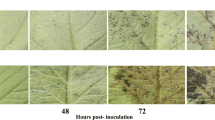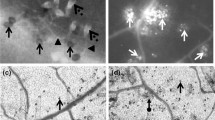Summary.
The interactions between Hordeum vulgare (barley) and two fungal necrotrophs, Rhynchosporium secalis and Pyrenophora teres (causal agents of barley leaf scald and net blotch), were investigated in a detached-leaf system. An early oxidative burst specific to epidermal cells was observed in both the susceptible and resistant responses to R. secalis, and later on, a second susceptible-specific burst was observed. Time points of the first and the second burst correlated closely with pathogen contact to the plasma membrane and subsequent cell death, respectively. HO2 •/O2 − levels in resistant and susceptible responses to P. teres were limited in comparison. During later stages, HO2 •/O2 − was only detected in 2 to 3 epidermal cells immediately adjacent to phenolic browning and cell death observed during the susceptible response. However, H2O2 was detected in the majority of mesophyll cells adjacent to the observed lesion caused by P. teres. In contrast to observations during challenge with R. secalis, no direct contact between P. teres and the plasma membrane at sites of reactive oxygen species production was evident. Preinfiltration of leaves with antioxidants prior to challenge with either pathogen had no effect on resistance responses but did limit the growth of the pathogens and inhibit the extent of cell death during susceptible responses. These results suggest a possible role for reactive oxygen species in the induction of cell death during the challenge of a susceptible plant cell with a necrotrophic fungal leaf pathogen.
Similar content being viewed by others
Author information
Authors and Affiliations
Additional information
Received May 2, 2002; accepted July 26, 2002; published online May 21, 2003
RID="*"
ID="*" Correspondence and reprints: Department of Plant Science, Waite Campus PMB1, University of Adelaide, Glen Osmond, South Australia 5064, Australia.
Rights and permissions
About this article
Cite this article
Able, A. Role of reactive oxygen species in the response of barley to necrotrophic pathogens. Protoplasma 221, 137–143 (2003). https://doi.org/10.1007/s00709-002-0064-1
Issue Date:
DOI: https://doi.org/10.1007/s00709-002-0064-1




